Advertisement
Sara Elise's Brooklyn Apartment Is Designed For Minimum Stimulation — But Maximum Joy

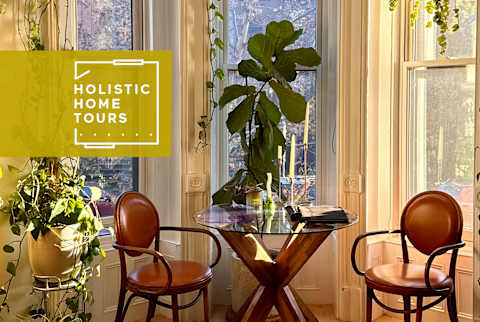
Coming home has a unique meaning for city dwellers. Returning to our (often very tiny) spaces is a way to disengage from the hustle and bustle outside and give our nervous systems a much-needed break.
This element of home is particularly important to Sara Elise (@saraelise333), an author, soon-to-be shop owner, and self-proclaimed pleasure doula living on the parlor floor of a brownstone in Bed Stuy, Brooklyn. "As an autistic person, I already have a wild clanging and clashing inside my head in response to the stimulation of the world around me, so I wanted to create a space that allowed me to breathe, rest, and think peacefully—a place to 'be' effortlessly," she tells mindbodygreen.
On this tour of Elise's apartment, we'll pick up some foundations of low-impact design, hear a few of the stories that infuse her environment with meaning, and learn about why making space for celebration and imagination is the key to an abundant home—and life.

What are three words that describe your design philosophy at home?
Intentional, earth-centered, tactile.
What are the guiding principles of your home's design?
I intentionally designed my Brooklyn home space to be a serene, low-stimulation environment because I wanted a place that felt soft and slow, in contrast to how the city often feels for me.
Also, I grew up with several siblings in a bustling, chaotic household. My parents' home was beautiful—but also loud, tense, and confining. I always knew that eventually, when I was ready (and had a care team in place with enough support), I would want to live by myself in a space that felt like the opposite of that—a space that felt open, light, and free.
I love designing interiors because having agency over the choices in the design process reminds me that I have agency over the choices in my life: I can intentionally choose to create spaces (and a lifestyle) that soothes rather than activates.
When designing my interior, I often think, What inspires me? What feelings do I want to be closer to?
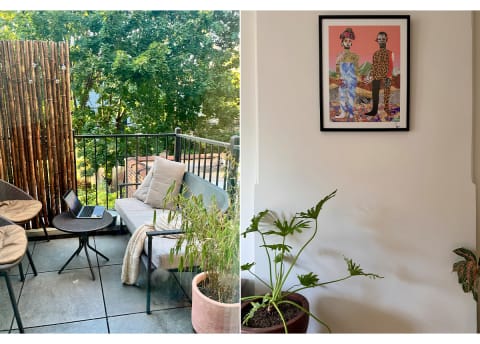
What are some ways you designed your space to be less stimulating than the average home?
I have an earth-toned palette for this space, which allows me to get really creative with textures, opacity, and shape of objects. Because my brain is super detail-oriented, maximalist design initially excites me—but eventually overwhelms me.
I realized that if I keep the color palette in more earthen browns and greens and incorporate mostly materials found in nature (oak hardwood floors, mixed metals, organic linen bedding, alpaca wool couch and pillows, etc.), then my head space feels calm and clear, and my mental health and overall well-being benefit.
But I love incorporating juxtaposing elements in the way I dress, so I also bring some of that into my spaces. With natural elements as the foundation, I'll incorporate some brighter pops of color and unique materials to contrast, like a neon orange fruit bowl or an acrylic side table, or a bright red monochrome movie poster.
When designing my interior, I often think, What inspires me? What feelings do I want to be closer to?
Finding a [home] with so many preexisting details already built in was a real treat. I wanted to have the original aspects of the brownstone, like the wall and ceiling moldings, continue to be some of the main focal points of the space. So, I decided to keep my furniture pieces more minimal.
This also means that I can bring in beautiful temporary items (like fresh-cut flowers or handmade soaps) without making the space feel overfilled or too cluttered. These things get consumed or die, and I can change the temporary items I bring in based on my mood, the season, etc.
I also prioritize having a clutter-free space. When my space has a lot of useless objects sitting around, my head space reflects that (and vice versa). Each object I bring into my home is something that I've curated with intention. I have mini altars everywhere, but I also love to think of my entire home space as a living, breathing altar: a sanctuary that's in constant evolution.
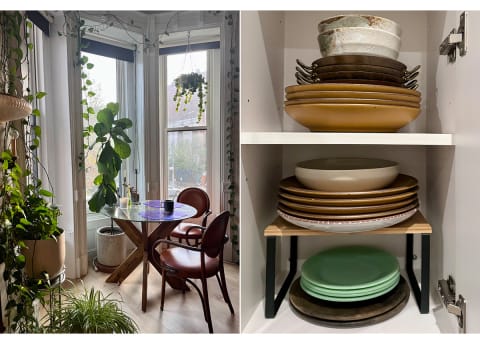
Does your home change at all from one season to another? If so, what changes are you making as we head into winter?
Yes! Just as I change my eating, I also change my home in small ways based on the season and time of year. This design practice (like most of my practices, I'm realizing) helps me feel more aligned and in flow with the rhythms found in nature.
Seasonally, I change my bed, bathroom, and daybed linens, the types of cut flowers and plants I bring in, and the scents of candles and incense I burn. I have a brilliant friend who creates seasonal playlists, so if I'm incorporating sounds, I also change the music and ambient sounds based on seasonal shifts.
I see you've written a book all about pleasure and abundance—what tips do you have for people looking to introduce more of these elements into their homes?
One of the most impactful ways to bring feelings of pleasure and abundance into your home is to host a celebration for people you love.
I talk a lot about the art of hosting and gathering for celebrations in my book A Recipe for More. Creating spaces for celebration is such an essential artistic practice and ritual for me.
I like to say, We celebrate our lives, we celebrate the work we have already done, we celebrate that which, in the words of Lucille Clifton, "has tried to kill us and has failed." Celebrating is a way to disrupt and dismantle the systems that want us to fail, and because of this, it is a radical act. And it infuses your home with an abundance of delicious energy and love.
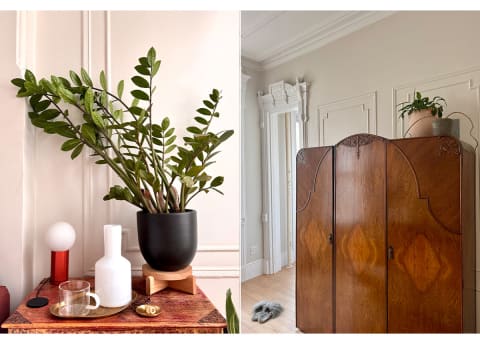
What noises can be heard in your home? What smells are there?
I always say that my home would be perfect if I could soundproof it because despite living on a one-way street and doing my best to intentionally curate a low-stimulation environment, I do still hear the sounds of the city from my front room! The young people next door coming home from school, the guys on my block riding their motorbikes, car music...
But that's also the beauty of living in the city and in my neighborhood. Hearing and remembering that I'm in the city, and specifically in Bed Stuy, while I'm in my space is part of what makes it so special.
I love to think of my entire home space as a living, breathing altar: a sanctuary that’s in constant evolution.
I'm very particular and picky about scent but love fresh air, so I'm sometimes in a battle with the city when the winds bring unpleasant smells my way. But I use an air purifier and often burn a variety of herbs, candles, weed, and incense to cleanse the energy in my space. If you're stopping by, you might smell onions and garlic softening in butter or olive oil since that's how most of my cooking begins.
I often incorporate the use of sound and scent in my home rituals too: I play soft ambient sounds (like sounds from the rainforest, ocean waves, healing-frequency meditations, or flutes) as I burn cleansing herbs, candles, and incense.
What's the most sentimental thing in your home, and what's the story behind it?
One of the most sentimental things in my home is the milky pink mid-century modern grape clusters that I have on display.
I found them in a vintage shop with my partner when we were beginning the initial stages of creating our vintage store (again Vintage Homewares + Interiors, which will be opening this year in Brooklyn!).
In our texts, when we first started dating, we used the grape cluster emoji to symbolize abundance. We'd use it in contrast to any scarcity thoughts either of us had. So finding that very random (and very heavy) grape cluster piece felt like a kismet sign that we were going in the right direction.
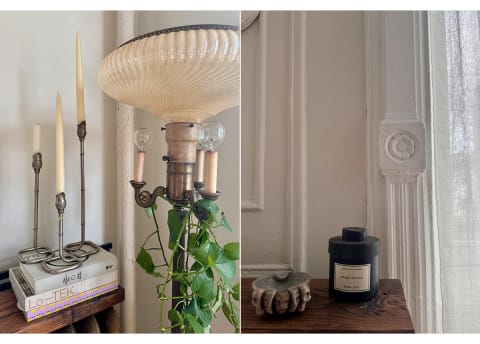
What does the word "home" mean to you?
Home to me means safety, relaxation, and getting to fully unmask and recharge my spirit. It's a place where I can be my most sprawled out, weird, disengaged from the world, focused, quiet, and centered.

I love the cartoon Steven Universe Future because (spoiler alert) it depicts a world outside of the war that the characters are fighting in the foundational plot of the series. My partner pointed out the brilliance in this writing: Usually, shows/most media depict the protagonist defeating the bully or the monster or the enemy, and then the show ends—that's it. But Steven Universe shows you how to imagine a world beyond just defeating the bully/monster/enemy/systemic structures that be. In this world, everyone can decide for themselves what they want for their lives, who they want to become, what feels like home.
Home, I think, can be—if we're lucky—a separate world that we create for ourselves, a utopia where we can decide (without being perceived) who and how we want to be.
Recreate the look
